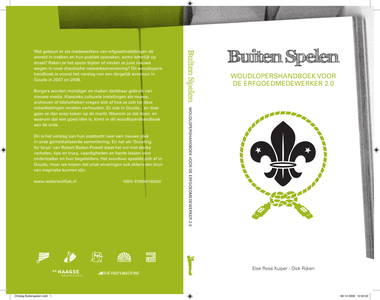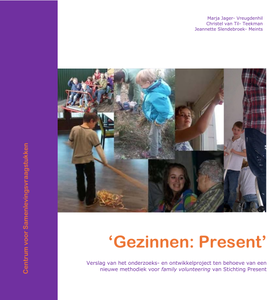Wie denkt dat het debat over Zwarte Piet een debat over ‘niets’ is, doet er goed aan twee dingen te beseffen. Allereerst dat dit in hoge mate gepolariseerde debat niet op zich staat. Integendeel, het is een voorbeeld (te midden van vele andere) van felle (over)reactie van veranderingsgezinde activisten enerzijds en behoudzuchtige burgers die zich in hun zekerheden bedreigd voelen anderzijds. Bron: Lessen uit crises en mini-crises 2014.
LINK
Wat gebeurt er als medewerkers van erfgoedinstellingen de wereld in trekken en hun publiek opzoeken, soms letterlijk op straat? Raken ze het spoor bijster of vinden ze juist nieuwe wegen in onze chaotische netwerksamenleving? Dit woudlopershandboek is vooral het verslag van een dergelijk avontuur in Gouda in 2007 en 2008. Burgers worden mondiger en maken dankbaar gebruik van nieuwe media. Klassieke culturele instellingen als musea, archieven of bibliotheken vragen zich af hoe ze zich tot deze ontwikkelingen moeten verhouden. Zo ook in Gouda... en daar gaan ze dan soep koken op de markt. Waarom ze dat doen, en waarom dat een goed idee is, komt in dit woudlopershandboek aan de orde. Dit is het verslag van hun zoektocht naar een nieuwe plek in onze gemedialiseerde samenleving. En net als 'Scouting for boys' van Robert Baden-Powell staat het vol met sterke verhalen, tips en trucs, vaardigheden en harde lessen voor onderzoeker en hun begeleiders. Het avontuur speelde zich af in Gouda, maar we hopen dat onze ervaringen ook elders een bron van inspiratie kunnen zijn.
DOCUMENT

Onderzoek naar de betekenis van de christelijke beroepsvorming die door de Christelijk Hogeschool Ede (CHE), de Gereformeerde Hogeschool Zwolle (GH) en Driestar Educatief Gouda (DEG) wordt aangeboden. In het onderzoek wordt in beeld gebracht op welke manier de christelijke beroepsvorming concreet zichtbaar is in de opleidingspraktijk, en daarnaast ook in hoeverre de alumni van hun opleidingen uit de voeten kunnen met de christelijke beroepsvorming in de dagelijkse praktijk van hun werk of vrijwilligerswerk.
DOCUMENT

‘Gezinnen: Present!’ is de naam van het onderzoeks- en ontwikkelproject waarin Stichting Present en het Centrum voor Samenlevingsvraagstukken samenwerkten aan de ontwikkeling van een nieuwe methodiek voor family volunteering. Deze rapportage laat de opbrengst zien van anderhalf jaar samenwerken. Present heeft een subsidie gekregen van ZonMw om een aanpak te ontwikkelen speciaal voor gezinnen die zich vrijwillig in willen zetten. In 8 lokale Present-stichtingen (Amersfoort, Dordrecht, Ede, Houten, Gouda, Utrecht, Almere en Zwolle) werd in het onderzoeks- en ontwikkel-project ‘Gezinnen: Present!’ deze aanpak in de praktijk uitgeprobeerd, onderzocht en ontwikkeld. Het project vond plaats in de periode januari 2011 tot en met juni 2012. In deze periode begeleidden de Presentcoördinatoren uit de genoemde plaatsen in totaal 68 gezinnen die zich vrijwillig inzetten voor een ander. Het Centrum voor Samenlevingsvraagstukken ondersteunde het ontwikkel-proces en voerde het onderzoek uit rond de 68 gezinspro-jecten die plaatsvonden.
DOCUMENT

Den camp vander doot is een Middelnederlandse vertaling van Le chevalier délibéré. Het is een heel precieze vertaling, waarschijnlijk is deze vertaling goedgekeurd door de auteur zelf.
DOCUMENT

PowerPoint presentation used at the Carbon Connects and CANAPE Final Conference on October 14, 2021 at Van Hall Larenstein University of Applied Sciences in Leeuwarden, the Netherlands.
DOCUMENT

Le chevalier délibéré by Olivier de la Marche is now largely forgotten. Immediately after its publication in 1483, however, it enjoyed great success. The text was disseminated throughout Europe and was held in particularly high esteem in the French-speaking parts of the Netherlands. Such was its popularity in this region that it came to have a profound effect on Dutch literature. The text was translated twice into Dutch, by Pieter Willemsz in 1492, as Vanden ridder welghemoet, and by Jan Pertcheval a year later as Den camp vander doot. Two very early editions offtie original French text were also published in the Netherlands. Moreover, wood cuts from the book were used in other volumes, and the first Spanish translations of Le chevalier délibéré were printed in Antwerp. Several Dutch authors were also directly inspired by this French poem, using it as the basis of their own work. Jan vaA den Dale and Jan Baptist. Hb,uwaer¥are particularly indebted to de la Marche. These writers were in turn highly successful, even if they have now lapsed into obscurity: Jan van den Dale was held in especially high regard, as his Wre vander doot was reprinted at least five times.
DOCUMENT

Het overkomt elke adviseur de laatste tijd. De klant wil ‘een totale web virale campagne’ die alle communicatieproblemen ineens verleden tijd maakt. Lekker gemaakt door stapels boeken en publicaties gebaseerd op slechts een paar succesvolle cases. Hogeschool Utrecht deed het afgelopen jaar onderzoek in opdracht van Creative Connection, een Utrechtse groep creatieve bedrijven, naar de succesfactoren van de inzet van social media bij communicatieprojecten. De komende weken doen we op Frankwatching verslag van de resultaten en lichten we een tipje van de sluier over het vervolgonderzoek waar we op dit moment mee bezig zijn. Vandaag deel 1: de doelstellingen.
DOCUMENT

Communicatie en media veranderen van structuur en inhoud nu onze samenleving zich transformeert naar een gedigitaliseerde netwerksamenleving. Alle bestaande spelers (overheden, bedrijven, culturele instellingen, burgers, etc.) gaan zich op nieuwe manieren tot elkaar verhouden. Betekenis en identiteit zijn hierin kernbegrippen waar actief mee geëxperimenteerd moet worden. Laboratorium Waterwolf richt zich actief en praktijkgericht op de veranderende rol van cultuur in deze nieuwe samenleving. Bestaande spelers moeten zichzelf opnieuw uitvindenklassieke 'zenders', werkend vanuit inhoudelijke autoriteit, zullen steeds vaker niet alleen zelf reflecteren en kennis ontwikkelen, maar juist een centrale rol spelen in het organiseren en inspireren van kennisontwikkeling en leerprocessen in de samenleving zelf. Dit schetsboek presenteert laboratorium Waterwolf: initiatiefnemers, partners, uitgangspunten, denkbeelden en onderzoeksagenda.
DOCUMENT

This is a case study which discusses the journey of a successful Ethiopian dairy entrepreneur. It turned out that the inclusiveness of the small holder farmer into the chain with fair incentive sharing mechainsms and guarenteed market access made her chain more efficient, reliable and profitable.
DOCUMENT
